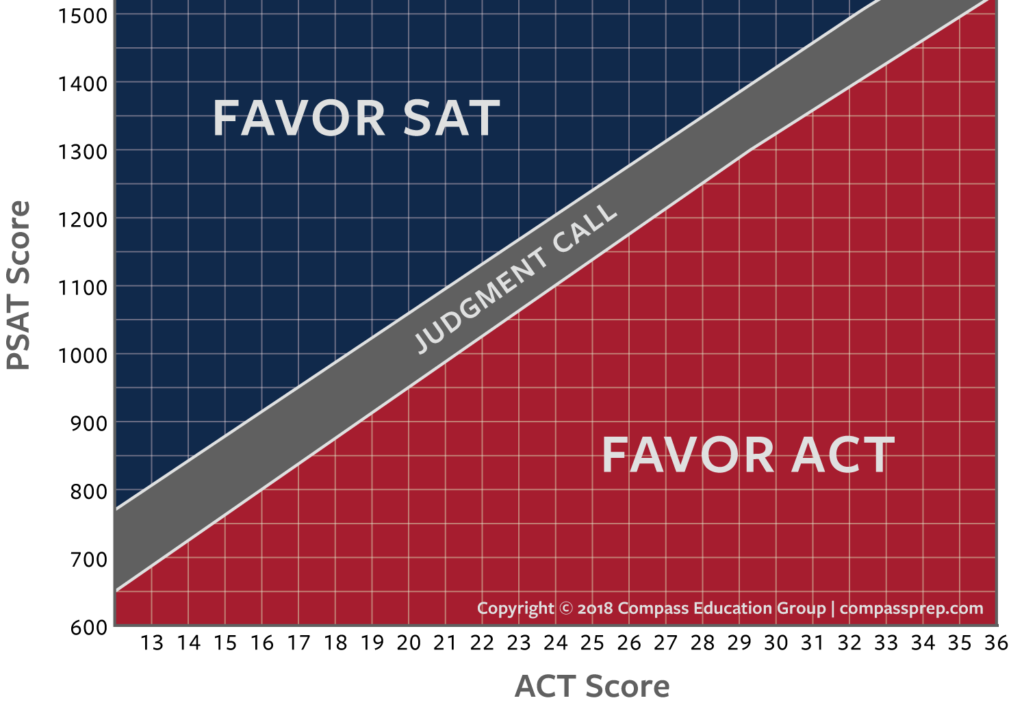
 Download a PDF Version
Download a PDF Version 
The PSAT has long been thought of as a gateway to the SAT, but it can be just as useful in helping students decide whether to choose the ACT instead. Many students have already taken a practice ACT or an official PreACT that establishes a testing baseline. When digital PSAT scores are available, it’s smart to compare scores to see whether there is any clear advantage.
Students who have not yet taken an ACT can invest the 3 hours required to take a practice ACT at a Compass location or from home via our online proctoring. For students impatient for official PSAT scores, a practice digital PSAT or digital SAT with Compass is also an option. An added benefit is that our score reports provide far more detailed insights versus what is provided by the one received from College Board or ACT. For instance, students can no longer review the questions they missed on College Board’s official digital PSAT.
Compass has analyzed available research and concordances to create an interactive comparison tool, as well as a downloadable chart and table. Although most students will find their digital PSAT and ACT scores intersect somewhere in the “Judgment Call” band, others will discover that one test or the other is a better fit.

 Download a PDF Version
Download a PDF Version
It is important to think about the relationship between digital PSAT and ACT scores as a range of options rather than as an all or nothing proposition. Concordance tables are used by colleges to compare digital SAT and ACT scores, so the tables are extremely useful to students when choosing which scores to send to colleges.
Deciding which score is “higher,” though, is different from deciding which test will be better for you in the future. A digital PSAT or an initial ACT score is only a starting point. Most students will continue to build subject and testing skills. Students in the “judgment call” zone should think through the testing process before making a commitment. Which test dates will be targeted? Are there test areas or characteristics that make one exam more appealing than the other? What are the test preparation options for each exam? How does National Merit fit into the mix?
Adam Ingersoll has written an excellent post on choosing between the SAT and ACT that outlines some of the factors students may want to consider. Compass directors are experienced in helping make those decisions. Our Essentials class is designed to help guide students through the test selection process while gaining a foundation of testing skills.

Parents and students wanting a more in-depth discussion of some of the issues surrounding digital PSAT and ACT comparisons may find the questions and answers below of use.
In order to understand how digital PSAT scores are compared to ACT scores, it is important to first understand how digital SAT and ACT scores are compared. While the ACT and SAT cover some of the same topics, they are very different exams. One cannot take a given score on the SAT and say that it equals a certain score on the ACT. Instead, the tests have a looser linkage known as a concordance.
In a proper concordance study, the results from real students who took both exams are compared via what’s known as equipercentile linking. Since the same students take both exams, percentile scores can be directly compared. A 90th percentile score on the SAT can thus be compared to a 90th percentile score on the ACT. In the summer of 2018, ACT and College Board released a concordance established through joint effort. With the release of the digital SAT, College Board has indicated that digital SAT scores are equivalent to paper SAT scores and so a further concordance study is not required.
PSAT scores are placed on the same scale as SAT scores. The idea is that a 650 on the PSAT represents the same achievement as a 650 on the SAT. To the extent that PSAT and SAT scores can be used interchangeably, they can also share a concordance.
The digital PSAT is a test designed for sophomores and fall juniors. The material is slightly easier than that of the digital SAT, so the top SAT scores are not achievable on the PSAT—even with a perfect answer sheet. The PSAT score range extends from 160–760 (320–1520 total) versus the SAT’s score range of 200–800 (400–1600 total). In much the same way that no PSAT score can represent the same performance as a 1600 on the SAT, no PSAT score can be concordant with a 36 on the ACT (and a student with a 36 should stick with the ACT!). In fact, there are no scores on the PSAT that definitively favor the SAT over ACT at ACT scores of 34 and higher. A high scoring PSAT student with a 34 or a 35 may want to consider both tests, but the PSAT does not represent a difficult enough exam to make a definitive judgment. To give an exaggerated analogy, the PSAT is the golfing equivalent of a par 3 course—not challenging enough to measure the most elite testers/players. A full SAT might be recommended in those judgment call cases.
While the relationship between digital PSAT scores and ACT scores should be consistent, students are advised to be more guarded about making definitive decisions based on the sophomore PSAT. Most students hold off on preparation for the SAT or ACT until at least the summer before junior year—almost a full academic year after the sophomore PSAT—and students’ skill-sets can develop quickly in that period. Ideally, test comparisons are made on exams taken in the same timeframe. It’s a good idea to avoid, for example, comparing an October PSAT score with a practice ACT score obtained in June of the following year. At minimum, the time difference should be a consideration when weighing performance.